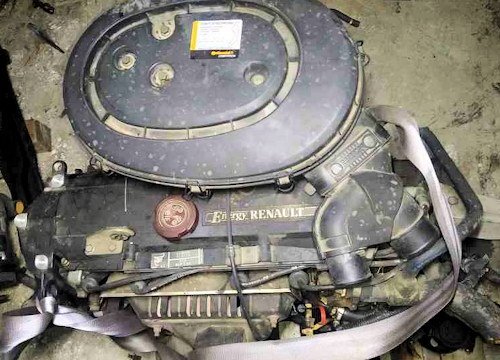Renault Type E engine (Energy) 1988 to 2005

The Energy engine, also known as “Type E” (E for Energy), is an four-stroke gasoline , with four cylinders developed and produced by Renault in the late 1980s , making its appearance on the Renault 19 also in some Dacia cars. Engine codes E5F-E7F 1.2L (1171cc) and E6J-E7J 1.4L (1390cc).
History
The Energy engine, also known under the code “engine E” or “block E” (E for Energy), is an internal combustion automobile heat engine, four-stroke gasoline , with four cylinders in line jacketed, cast iron block, cooled. by water, fitted with a five-bearing crankshaft, with overhead camshaft driven by a toothed timing belt, with an aluminum cylinder head , eight overhead valves, developed and produced by Renault in the late 1980s , making its appearance on the Renault 19 .
At the end of the 1980s, the “ Cléon-Fonte engine ” which still fitted the R4 , Super 5 , R9 , R11 , Express , etc. was now getting old by its design with its lateral camshaft. Competing brands had mostly opted for modern engines with overhead camshafts. The Cléon-Fonte engine appeared in 1962 on the Renault Florida S and Renault 8. To launch the replacement for the R9 and R11 which will be the R19, Renault had to offer a more modern engine. Renault will modernize its old Cléon-Fonte engine by capping it with a brand new hemispherical cylinder head with an overhead camshaft, driven by a toothed timing belt, which will give birth to the Energy engine in 1988, on the R19.
The direction of rotation of this motor is clockwise (distribution side), like its predecessor. This new engine will also be used on the Clio I , Clio II , Mégane I , Mégane Scénic I , Kangoo I and even Express. The Energy engine also fitted the Renault 9 in Argentina, Colombia and Turkey. But in 1993, Renault by launching the Renault Twingo will be forced to reuse its Cleon-cast engine, because the Energy engine by design with its hemispherical cylinder head which places the exhaust at the front of the cylinder head could not fit under the hood of the little Twingo.
The 1.2 Energy ( type E7F ) will gradually be replaced by the D engine ( type D7F ) in 1996 on the Clio, following new pollution standards and its high consumption compared to the competition. The D7F engine will simultaneously replace the 1.2 Energy engine on the Clio and the 1.2 engineCléon-Fonte of the Twingo. As for the 1.4 Energy ( type E7J ) of the Mégane I , it will be replaced by the K engine ( type K7J ) on the Kangoo I phase 2 , Logan I , Sandero I .
The Energy engine will evolve to become the “K engine” which will make its appearance on the Mégane I. The main modification of the K engine is made in the machining of the cylinders, since this engine no longer has removable liners. The Energy engine cylinder head is retained on the eight-valve petrol versions. The K engine will also be developed in sixteen-valve versions and will also be available in a diesel version ( K9K engine , 1.5 dCi ).
Models equipped with this engine
- Renault 19
- Renault Clio I
- Renault Clio II
- Renault Mégane I (and Mégane Scénic I )
- Renault Express
- Kangoo I
- Renault 9 (Argentina, Colombia, Turkey)
- Dacia SupeRNova
- Dacia Solenza
Technical
-
Renault Type E engine (Energy) 1988 to 2005
Displacements Engine types
Engine types
E5F - E7F
E6J - E7J
Displacement (cc)
1,171
1390
Renault Type E E6J 1390 cc engine (Energy) Technical details and specifications
No. of cylinders 4/OHC
Capacity 1390 cc
Compression ratio 9.5:1
Firing order 1-3-4-2
Suitable for unleaded petrol Yes
Ignition system Type Renix AEI
Fuel system Make Weber Type 32-32 TLDR
Diagnostic socket Yes
Ignition coil Make Renix
Distributor Make Ducellier RE 252
Fuel system pressure 0.17-0.32 bar
Oil pressure 3.0 bar @ 4000 rpm
Thermostat opens 89°C
Starter motor Make Paris Rhone Type D9E
Maximum cranking amps 149-182 A
Alternator Make Paris Rhone Type A13N87
Regulated voltage 13.4-14.4V© Motor car History


